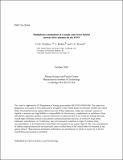| dc.contributor.author | Wallace, Greg M. | en_US |
| dc.contributor.author | Bohm, T. | en_US |
| dc.contributor.author | Kessel, C.E. | en_US |
| dc.date.accessioned | 2025-03-21T20:20:28Z | |
| dc.date.available | 2025-03-21T20:20:28Z | |
| dc.date.issued | 2020-10 | |
| dc.identifier | 20ja068 | |
| dc.identifier.uri | https://hdl.handle.net/1721.1/158693 | |
| dc.description | Submitted for publication in Fusion Science and Technology | |
| dc.description.abstract | The Fusion Nuclear Science Facility (FNSF) is a proposed tokamak reactor with the mission to investigate operation of a fusion reactor in a nuclear environment. The high neutron fluence component of the FNSF mission requires steady-state operation for extremely long pulses (t_{pulse} ∼ months) at full power. Plasma sustainment and current drive will be critical components of a successful FNSF. COMSOL Multiphysics software is used for combined radiofrequency (RF) and thermal simulations of the lower hybrid current drive (LHCD) antenna system. These simu- lations consider the resistive RF losses in the antenna including realistic surface roughness and a range of potential materials. The thermal analysis adds volumetric nuclear heating, plasma heat flux on leading edges, and electromagnetic radiation from the plasma to the RF heating calculated by COMSOL. Additional neutronics calculations have been performed to determine the impact of these antenna designs on activated waste disposal for the materials considered. The simulations show that it is technically feasible to implement a fully-active multi-junction (FAM) rather than a passive-active multi-junction (PAM) style of antenna if the septum between adjacent waveguides is sufficiently wide and the thermal conductivity of the structural material is sufficiently high. The FAM has the benefit of higher achievable power density with respect to the PAM, which results in a more compact antenna with potentially lower impact on neutron shielding and tritium breeding. These considerations point to tungsten rather than steel as the preferred structural material in constructing the antenna. | |
| dc.publisher | Taylor & Francis | en_US |
| dc.relation.isversionof | doi.org/10.1080/15361055.2020.1858672 | |
| dc.source | Plasma Science and Fusion Center | en_US |
| dc.title | Multiphysics simulations of a steady-state lower hybrid current drive antenna for the FSNF | en_US |
| dc.type | Article | en_US |
| dc.contributor.department | Massachusetts Institute of Technology. Plasma Science and Fusion Center | |
| dc.relation.journal | Fusion Science and Technology | |
